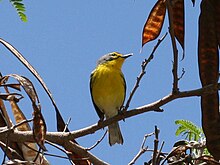Adelaide's warbler
| Adelaide's warbler | |
|---|---|

| |
| Scientific classification | |
| Domain: | Eukaryota |
| Kingdom: | Animalia |
| Phylum: | Chordata |
| Class: | Aves |
| Order: | Passeriformes |
| Family: | Parulidae |
| Genus: | Setophaga |
| Species: | S. adelaidae
|
| Binomial name | |
| Setophaga adelaidae (Baird, 1865)
| |
| Synonyms | |
|
Dendroica adelaidae Baird, 1865 | |
Adelaide's warbler (Setophaga adelaidae) is a bird endemic to the archipelago of Puerto Rico belonging to the genus Setophaga of the family Parulidae. The species is named after Adelaide Swift, daughter of Robert Swift, the person who captured the first specimen.
Description
The S. adelaidae complex was originally considered a single species, with three populations occurring in Barbuda, Puerto Rico and St. Lucia. Each of these populations were regarded as a subspecies, S.a. subita, S.a. adelaidae and S.a. delicata respectively. These subspecies were later elevated to species rank as the Barbuda warbler (Setophaga subita), the St. Lucia warbler (Setophaga delicata) and Adelaide's warbler.[2]
In 2011, the American Ornithologists' Union reclassified the Parulidae, which resulted in D. adelaidae being transferred to genus Setophaga.[3]
Adelaide's warbler has gray upperparts with yellow underparts. The species has a yellow line above the eye and a white half-moon below it. Its average length is 12 cm and its average weight is 7 g.
Adelaide's warbler occurs in the main island of Puerto Rico and in the island municipality of Vieques. The species occurs mainly in dry forests in the southern region of Puerto Rico such as the Guánica State Forest, with some occurrences in the northern moist forests and the central mountain range, Cordillera Central.
Adelaide's warbler is an insectivore which gleans insects from the mid-top areas of the forest. It is also known to eat, although very rarely, spiders and small amphibians such as coquís. The species usually travels in mixed flocks which commonly include Puerto Rican todies, vireos and other New World warblers. Adelaide's warblers build nests at heights of 1 to 7 m in which the female deposits anywhere from 2 to 4 white eggs. The eggs usually contain small brown spots.
| External audio | |
|---|---|
| Bird Call | |
See also
- Fauna of Puerto Rico
- List of birds of Puerto Rico
- List of endemic fauna of Puerto Rico
- List of Puerto Rican birds
- List of Vieques birds
- El Toro Wilderness
References
- ^ BirdLife International (2012). "Dendroica adelaidae". IUCN Red List of Threatened Species. 2012. Retrieved 26 November 2013.
{{cite journal}}: Invalid|ref=harv(help) - ^ Staicer, Cynthia A. (October 1996). "Acoustical features of song categories of the Adelaide's Warbler (Dendroica adelaidae)" (PDF). The Auk. 113 (4): 771–783. doi:10.2307/4088856.
- ^ Chesser, R. Terry; Richard C. Banks; F. Keith Barker; Carla Cicero; Jon L. Dunn; Andrew W. Kratter; Irby J. Lovette; Pamela C. Rasmussen; J. V. Remsen; James D. Rising; Douglas F. Stotz; Kevin Winker (2011). "Fifty-second supplement to the American Ornithologists' Union Check-List of North American Birds". Auk. 128 (3): 600–613. doi:10.1525/auk.2011.128.3.600.
Further reading
- "Adelaide's Warbler – Dendroica Adelaidae". Oiseaux.net. Archived from the original on 7 March 2006. Retrieved April 7, 2006.
- (in Spanish) Sociedad Ortinológica Puertorriqueña – Reinita Mariposera
- Oberle, Mark (2003). Las aves de Puerto Rico en fotografías (in Spanish). Editorial Humanitas. ISBN 0-9650104-2-2.

